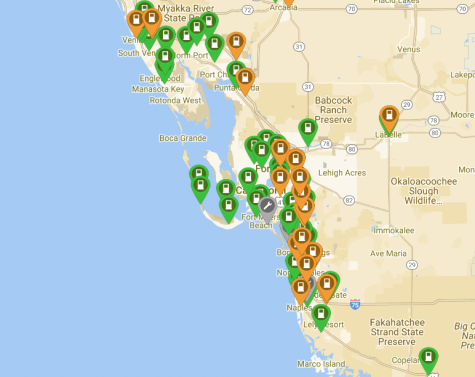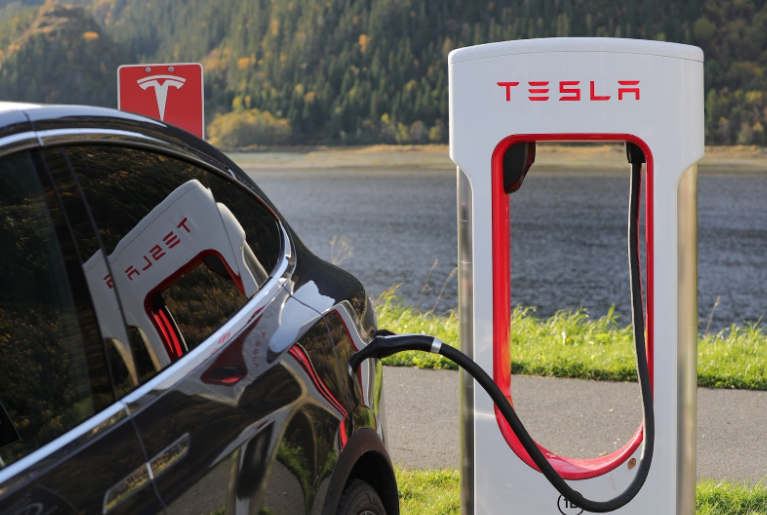Where’s The Infrastructure For EV’s In SWFL?
Pixabay
(Pixabay via Pixabay License) A Tesla electric vehicle charging at a Tesla Supercharger. Currently, there are no public chargers on Marco Island.
May 23, 2023
Gone are the days of railways connecting the East, West, North, and South. Late President Eisenhower’s Interstate Highway System provides travelers with a quicker route to travel long distances, with rest stops and gas stations in between.
In the past decade, the push for going all-electric has been in high demand across the United States. We’ve seen the results in our streets here in Southwest Florida. Downtown Naples by 5th Avenue, an area that was once home to many gas-powered supercars that could be seen on Friday nights, has become a haven for the latest and greatest EVs. A Tesla Model X here, a Rivian R1T there, heck sometimes even a Hummer EV. On Marco Island, a Tesla can be seen in nearly every parking lot. Seasonal residents keep them tucked away in their garages, while others can be seen in the driveways of full-time residents. Little by little, our paradise in Southwest Florida is becoming a hub for EVs, but where is the infrastructure to support this?
Sales data from Experian Automotive AutoCount shows that a total of 67,952 new cars were sold across Southwest Florida in 2022. Out of those cars, 3,649 were EVs – equating to about 5.3% of sales.

On the national level, car rental companies like Hertz have expanded their fleet from their traditional gas-powered SUVs and sedans to include electric vehicles as well. Hertz claims that they now offer “the largest electric vehicle (EV) rental fleet in North America” as part of their dedication to “personalized service and seamless travel.” These new EV additions have been evident here on Marco Island, with the J.W. Marriott’s Hertz rental fleet seeing multiple Polestar and Tesla vehicles.
If one were to travel from Marco Island to Tallahassee, a 450-mile trip would require stops for fuel along the way, but some EVs promise a range of over 500 miles. If there are no stops for a restroom break on the way, one can get from A to B with a fully charged battery. It seems promising until you realize that the infrastructure to support these electric-powered vehicles is severely lacking across Southwest Florida.
When consumers purchase an electric vehicle, they are either given an at-home charger or they are offered one at an additional cost to the already high price of the vehicle. In the same way that we plug our smartphones in at night to charge overnight, EV owners plug their cars in at night. At first, it seemed like a strange concept, but as the popularity of EVs has grown in recent years, it has become the new norm.
In Charlotte, Lee, and Collier Counties, there are a total of 369 charging stations, which sounds like a big number until you realize that most of them are car dealership charging stations. According to PlugShare, Charlotte County has 59 public charging stations. Lee County has a total 201 public charging stations, 30 of which are free-to-use. Collier County has 119 public charging stations, where only 18 are free-to-use. The US Census Bureau reports that there are over 1,300,000 residents combined in these three counties. Considering the population and the considerable sprawl across SWFL, it seems as though there would ideally be more charging stations – but there aren’t.
For the tourist destination that Marco Island is, it would be expected that there be sufficient charging stations around the island to support the rental cars. Unfortunately, however, there are only four charging stations on the island, and they are at the major resorts on the island, and not for public use unless one is a guest at the resort.
For those who are permanent residents, or those that are seasonal, a public charging station would be convenient. Especially for those who come to the island from the east coast in an EV, a quick charge would likely be needed for when they want to return to their homes.
Although it is a still-growing industry, the push for the replacement of the gas-powered vehicle with EVs far outweighs the infrastructure that is in place, making it less ideal for one to purchase an EV in this area. As the years go on however, there may be a possibility that areas like Marco Island offer public charging stations for a cost, but the question that arises from that would be; Where would the charging station be?








